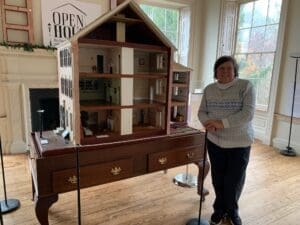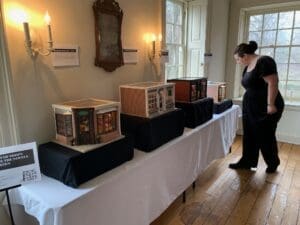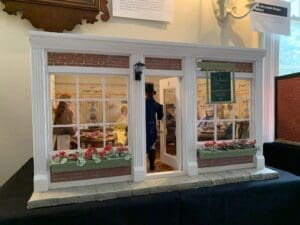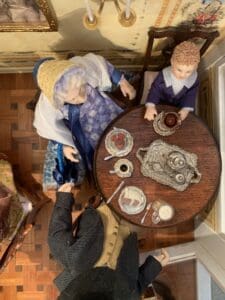

Read House in Historic New Castle has 20 minature scenes on display through the house for the holidays.
And, now, for something a little different.
And by little, we mean miniature.
And by miniature, we mean recreations of period rooms that could fit into shoeboxes, including a “street” depicting four shops mentioned in Jane Austen books.
The 20 displays, created by and on loan from the First State Mini Club, are spread throughout the Read House in Historic New Castle and are meant to call attention to the house’s own Archibald Alexander dollhouse, a miniature recreation of a real home.
Read House is raising money to send the dollhouse to the University of Delaware for conservation. The work will be done for free, but the house has to be crated to be moved, and that process is spendy.
The miniatures also add interest and cheer to the house’s holiday decorations, which include a gingerbread house by Joe Daigle that offers a deconstructed look at the house’s architecture.


Television baking champion Joe Daigle created this deconstructed look at the architecture of Read House.
This focus on the holidays is part of the efforts of the Read House & Gardens to raise the profile of the historic home, which was the largest in the state for 100 years.
It was built from 1797 to 1804 by George Read II. His father signed the Declaration of Independence and Constitution and served as governor, chief justice and U.S. senator in Delaware.
The house on the Delaware River was lavishly appointed for a home for that time. Read II even bought the property across the street from his so that his house would always have an unobstructed view of the river.
The younger Read assumed he was building a home that would befit the great man he assumed he would be, said Deborah Harper, curator of education at the house.
He never was.
Read House reality
Harper wants visitors to see more of the real house, the real people and the real issues of the time when they visit a historic site.
“It’s not a typical historic house because if we don’t play phony baloney coloney here,” she said.
She believes many people visiting historic homes assume they are walking into a house as it would have existed when it was built.
“You are not stepping back in time,” she said. “You are stepping into a curated space, and decisions are made and things are added and things are taken away. And whenever we add something, that says something about the person who’s adding it.
“But whatever you take away means we lose part of the story as well. And so what part of our history do we lose by the stories we choose not to tell? So I think it’s a more nuanced and sophisticated interpretation than your typical historic house.”
Read’s story has a lot of facets.
He never got the appointment to some prestigious post that he hoped for, even though he spent most of his life in pursuit of that, dying in great debt.
The house’s contents had to be sold to pay those debts, and the house rented out. Fairly quickly, it was sold because the family needed the money.
“What does it profit a man if he builds the most magnificent house in the state, but he is personally unhappy and bankrupts his family,” Harper asks.
LIke many of the time, Read also had slaves. He had servants, indentured servants and free black indentured servants, too.
“So there’s a really complex thing going on right there,” she said.


This wallpaper depicting the arrival of William Penn in New Castle is historically inaccurate, but valuable because of that, says Read House’s curator of education.
She points to painted wallpaper in the dining room where Daigle’s gingerbread house is on display.
It’s supposed to depict William Penn arriving in New Castle in 1681 being greeted by the Dutch and Swedes as well as a group of Native Americans.
However, the painter depicted the Native Americans dressed as Western Plains people, not as the local Lenapes would have been. Some people have suggested that the Read House should remove the wallpaper.
“And we’re like, no, because if we take off the wallpaper, we lose the chance to tell the story that you need to question what you see in historic depictions, in historic texts,” Harper said. “Even when you go into beautiful historic house museums, they are not perfectly preserved Brigadoons. Choices have been made.”
Choosing to use First State Mini Club creations was an easy one because the group started as a result of the Archibald Alexander House.
It was designed in the 1970s by Lyt and Betty Lee Patterson as a miniature replica, done in a 1-inch scale, of their New Castle home at 28 East Third Street.
- Read House curator Deborah Harper with the Archibald Alexander dollhouse, a minature recreation of a real New Castle home.
- While most of the rooms in the Archibald Alexander dollhouse have been emptied of their furnishings, a few are left decorated.
- The Read House collection of miniatures includes this violin that can be played.
The First State Mini Club was chartered by the Pattersons in 1977, and the first meeting of the Club was in their home. The dollhouse was donated to the Delaware Historical Society in 1998.
The designs on display range from elegant rooms — a 1782 Blue Room by Augie Phillips; a Colonial Sitting Room from Mary Ellen Raun and Leslie Raun Shaffner; and the formal Delaney Room, created by Lauren Delaney George — to a whimsical bathing scene, appropriately enough on view in the room used for baths.
Some include holiday scenes, such as the Wedgewood Blue Regency Tea Party by Augie Phillips and the Snowman House by Lois Weyer.
One of the biggest delights, though, is the street of shops inspired by stores named in Jane Austen’s books or important in her life.
- The street of shops mentioned in Jane Austin books features scenes from ‘Emma,’ ‘Persuasion’ and ‘Sense and Sensibility.’
- This scene from ‘Persuasion’ features Capt. Frederick Wentworth walking into a tea shop in Bath.
- The street of shops mentioned in Jane Austin books features scenes from “Emma,” “Persuasion” and “Sense and Sensibility.”
Created by Augie Phillips, they include Hatchard’s Bookstore in London, Gray’s Jewelers in London’s Sackville Street, Molland’s Tea Shoppe in Bath and Ford’s Dry Good Shoppe in Highbury.
The scenes include shopkeepers, shoppers, customers having tea and a display of goods.
The details are fun: All the books in the book store were real books that would have been on sale or even were read by Jane Austen or her sisters
The scene in the tea shop depicts ‘Persuasion’s’ Anne Elliot meeting her former boyfrield Capt. Frederick Wentworth there, triggering a revival of their romance.
Ford’s Dry Goods appears in “Emma.”
Gray’s Jewelers was mentioned in a scene from “Sense and Sensibility.”
IF YOU GO
Read House and Gardens LIT for the Holidays is open Dec. 28-30 and Jan. 4-6. The house at 42 The Strand in Historic New Castle is open from 11 a.m. until 4 p.m. Interior tours begin on the hour, with the last tour at 3 p.m. Tickets are $10 adults; $8 military/senior/student; free for ages 5 and below; $2 for Museums for All and Art-Reach ACCESS Delaware patrons. The mini exhibit alone is $4 and is self-guided while the house is open. The garden is open from dawn until dusk. After Jan. 6, the house closes until March 1. For more information, go to its website or email [email protected].


Betsy Price is a Wilmington freelance writer who has 40 years of experience.
Share this Post














